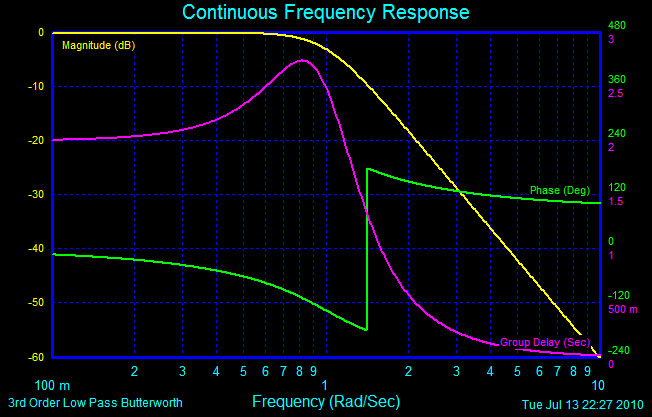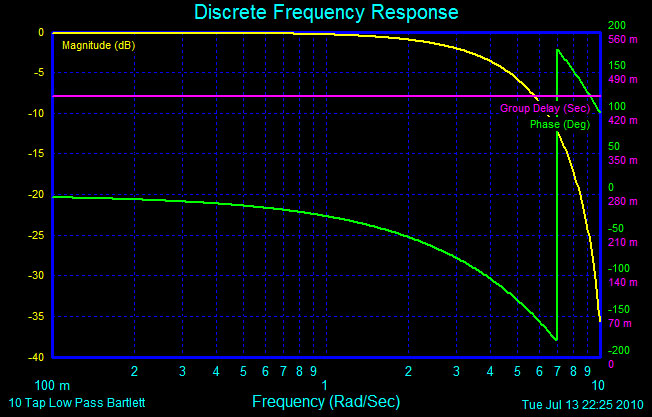Just finished reading "Behind The Glass - Top Record Producers Tell How They Craft The Hits" by Howard Massey. Fascinating read... Massey interviews 37 producers/engineers.
In an interview with Mick Glossop (Van Morrison, Frank Zappa & many more), Glossop says...
"Another thing I do is that I have an AudioDesign Scamp rack, and I have a couple of modules which are frequency splitters designed for band compression for radio use. You put a signal in, and it's got four outputs for low, low/mid, high/mid and high, so you can split the frequency signal up into four components. But then it has four inputs which combine those four components back to the original, so if you take the four feeds out and put them straight back in again, there's no difference in sonic quality because it's designed to have no phase shift;... " "So it means you can take just one band of the signal, compress it and do whatever you want with it - pan it, whatever - but if you process it in a mono way, you can feed it back in with the other bands. "
Now I use multi-band compressors. That's understood. But it does seem it would be cool to be ably to split up the signal as described and be able to do whatever processing you wanted to with that single band.
I googled "AudioDesign Scamp" and variations and got nowhere.
So I'm wondering if any of you know of either a software plugin or a hardware box that can do this type of signal splitting?
Jeff
Comments
Orban makes this type of limiter/compressor for radio stations.
Orban makes this type of limiter/compressor for radio stations. I think that the early ones were called "Optimods" .
I found the web-page. Bob Orban invented this signal process. Some papers on the theory of operation.
Scamps were on the recording scene for a short while in the very
Scamps were on the recording scene for a short while in the very early 80's, basically copies of the Allison modules. You can use pretty much any electronic (i.e., "active" ) crossover to divide the signal
into different bands and send them out to different processors. The issue that you will have is that, while that sounds good on paper, the end result will be marred by the phase shift of the crossover's filter slopes. The better the crossover, the less phase shift. BSS and the afore-mentioned Orban are some ofthe better makes, as are Ashly and Rane. All 4 makes can be found at bargain prices on e-Bay these days, and they beat the snot outta the new stuff from Samson, Beh%^&%r, and the like.
[[url=http://[/URL]="http://www.transaudiogroup.com/drawmer/pro-
[[url=http://[/URL]="http://www.transaud…"]Drawmer 3-Sum [/]="http://www.transaud…"]Drawmer 3-Sum [/]
Thanks for the replies! Can't seem to find any availability of
Thanks for the replies!
Can't seem to find any availability of the RNDigital Spl-izer anywhere. The Drawmer 3-Sum seems to be what I'm looking for, though for budget reasons I'll have to wait a while to purchase one.
Good to know it's there when I'm ready.
Thanks again!
Jeff
Audio Design Recording made Scamp racks and various rackmount pr
Audio Design Recording made Scamp racks and various rackmount processors like the Compex and Vocal Stressor... they also made a thing called a TransDynamic which is a "frequency splitter" ... really all this is is a three way stereo crossover that sends hi mid and low out to effects loops that then return and get summed back together. The most blown-out implementation I saw for this was a TransDynamic and three stereo Compex units. I have a TransDynamic on a shelf somewhere. It has some metering and maybe some overall limiting function but beyond that it's not special.
You can use ANY decent active crossover, two or three way, and feed the bands out to processors and then bring those back up on faders and recombine. It works really well...
For an all in one analog hardware box version you'd be looking at something like a Tubetech SMC-2BM... which I've used and it's pretty neat... a rebuilt Crown VFX2 crossover split to an LA-2 and an MC77 is pretty groovy for bass guitar... get a crossover and experiment... it's fun
most of the filters you'd find in analog crossovers and filters
most of the filters you'd find in analog crossovers and filters in general will introduce phase shift. Depending on how many filter sections or poles there are and how the thing is configured you'll see more or less phase shift, in degrees, at the crossover or turn over points. You can test to see what this actually is doing by taking the bands straight into console faders and summing them back together... get your gains matched and then swoop or switch crossover frequencies and listen for the shifting artifacts... or you can measure, do pink noise... most good active crossovers sum back together pretty well - but YMMV
In the digital domain multi-band processors do not have to shift phase.
If I do multi-band processing as an effect I am probably not caring much about what happens at the crossover points and since the gain shifting and small group delays in the actual devices will probably smear things around a bit more - but as an effect you get to a point where it's working for the track and there you go.
If you want purity you'll get the mic in the right place (or the pickup or whatever) and get the sound at the source and hopefully you won't need to do anything like multi-band processing which is automatically not natural sounding.
For mastering I use a TC M6000 with the mastering for both stereo and surround licensed. Once you figure out the interactions you can do some pretty effective dynamics control without killing it and there you don't have an issue with phasing
oh - and Scamp modules and Allison?... If you mean Allison like
oh - and Scamp modules and Allison?... If you mean Allison like Keypex, Gainbrain etc... became Valley - not at all - not close.
Audio & Design Recording
Scamp Modules...
F300-S Expander/Gate - nothing like Keypex
S01 Comp/Lim - nothing like Gain Brain
S03 Sweep EQ
S04 Parametric EQ
S05/06 Dynamic Filter/Gate - these are really cool - hi pass and low pass filters that open up to let program through
S23 Pan Effects - this is like a panscan in a scamp slot
S24 ADT - 2 wide delay module - these are quite cool
S25 De-Esser
Rackmount Gear...
F-600 - compressor - a very early FET limiter
F769X-R Vocal Stressor - 4 band parametric and a compex with router switcher
TransDynamic - three band stereo crossover splitter re-combiner
Gemini Easy Rider - nice
Express Limiter MK 3 - these were useful
F760X Compex - these are great when they are cleaned up and working properly
Most analog crossovers uses Butterworth filters. Here is a spec
Most analog crossovers uses Butterworth filters. Here is a spec diagram for such filter:
Here is a typical digital filter diagram:
None of this filter is perfect in the phase domaine. The main advantage of the digital solution is a perfectly linear group delay. But that also means some latency.
In all cases the reconstruction (sommation of the splitted bands) is artifact free only if all bands have the same gain.
If you looking for a transparent processing you should consider putting an EQ on your compressor sidechain. That's the cleanest way to obtain a frequency sensitive dynamic processor.
Typical of an FIR digital filter, yes. These can be run off-line
Typical of an FIR digital filter, yes. These can be run off-line, where pure time delays are of no consequence. To avoid delay, most real-time digital systems use IIR filters, which have characteristics similar to analog filters, including non-linear phase.
What do you mean by "None of this filter is perfect in the phase domain"? The linear phase curve you plotted is simply the result of a constant non-zero group delay, and is perfect.
My comparison between the Scamps and the Allisons was simply the
My comparison between the Scamps and the Allisons was simply the concept of their modular design, similar to the API 500 series. As far as performance is concerned, I used both makes, mainly the Allison gear, many moons ago. The Kepexes were twitchy and could easily chatter, but the GainBrains were pretty useable, considering the technology of the time. I still have a Valley People DynaMite that I will NEVER sell...I sold the Scamp line for a while, and their audio performance was better, but customers complained about power supply issues. Too bad that neither company is around anymore.









I do own a copy of the RNDigital spl-izer, which exactly what yo
I do own a copy of the RNDigital spl-izer, which exactly what you are asking for.
I'm not sure if you still can buy it, but if you can put your hand on that one, that should do the trick.
N.